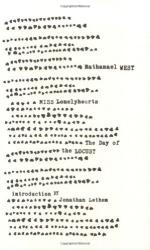|
This section contains 183 words (approx. 1 page at 300 words per page) |

|
West's works follow in the tradition of the most famous deadly serious satirist, Jonathan Swift, who wrote, besides Gulliver's Travels, "A Modest Proposal" (1729) for improving the British treatment of the Irish by having them raise the Irish children for meat.
Swift follows the tradition identified with the Latin satirist, Juvenal.
Miss Lonelyhearts, as a holy fool, is also represented in Dostoevsky's The Brothers Karamazov (1879-1880), A Raw Youth (1875), The Idiot (1868), and Crime and Punishment (1866); in Voltaire's Candide (1759); and in Isaac Bashevis Singer's short story "Gimpel the Fool" (1957).
Franz Kafka gives a similar intense, unnatural, disordered, violent effect using similar incredible-but-convincing imagery and a similarly deadly-serious humor. Dashiell Hammett, e.g., in The Maltese Falcon (1930), is noted for his similarly harsh stylization.
The barren world of West's books resembles that in T. S. Eliot's The Waste Land (1922). West's use of images is like that of the Imagists...
|
This section contains 183 words (approx. 1 page at 300 words per page) |

|




